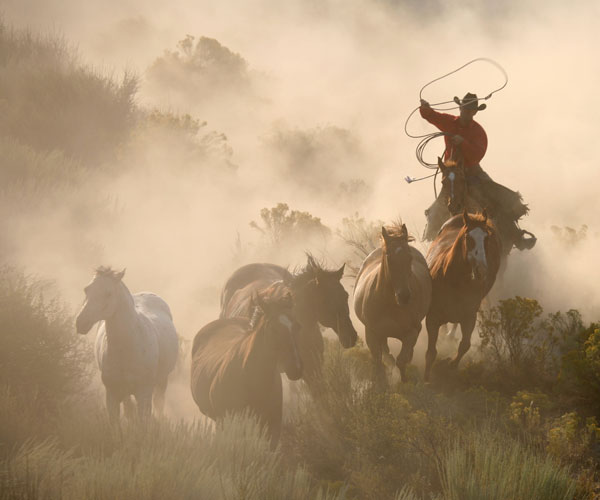Not so long ago, it was common to find “wild” horses on western Canadian rangelands. They were horses that had escaped from ranchers, miners and pack trains or had been born in the wild from once-domestic stock.
There were some that wore brands, but most had never been handled. In the ’20s and ’30s, before helicopter roundups, cowboys could chase wild horses. If luck was with them, they might even catch a few. It was a brutal way to earn a dollar orto find a potential saddle horse, because chasing wild horses meant long hours of hard riding.
There were numerous ways to catch them; a cowboy’s choice of technique had to do with terrain, weather and personal preference, ranging from traps to tiring them in deep snow. One of the more exotic methods — described by Jo Fliegerand used in the Cariboo area by Swedish homesteaders — employed cross-country skis in deep snow to chase and fatigue the horses so riders could herd them into corrals. Problem was, the homesteaders weren’t horse-breakers, so they hired Jo toget the captured horses started.
 |
| Photo courtesy Istock photo / World Wide Images |
Technically, there’s but one species of wild horse still in existence, the Przewalski horse of Mongolia. “Wild” horses today in the Canadian West are feral, but live within the patterns of wild horses. That means the dominating forces in their lives are climate, predator-prey relations and the dynamics of herd behaviour — as opposed to constant human intervention. Catching wild horses required a horseyou could trust, skill and technique, lots of perseverance and a willingness to ride through the roughest country, with little thought of caution.
A band of horses would typically haveas many mares as a particular stud could capture and hold. When the band was onthe move, a dominant mare would take the lead while the stud would drive the bunch from behind.
It would take some scouting around to find horse tracks in the snow, perhaps where horses had been pawing for feed. Once found, a rider in more open country could approach the horses at a flat-out runto get as close to the mares as possible. The stud would charge as a challenge; this diversion would allow a second rider to approach and start driving the mares.
If they appeared really wild, the riders would drive the horses for a while to tire them out before attempting capture. If you had three or more riders, you could geta bunch running and then just stay with them, to dog them, as it were. You couldn’t get too close, or the mares would split up. The trick was to get just close enough to keep them on the run. If the horses stopped, then the riders would, too. Sometimes, the stud would split off, tryingto get the riders to chase him so the marescould escape — but riders would ignore thestud to stay with the mares.
Wild stallions are smart and wily. A stud would try to lose the riders by taking them in a big circle. So, before the chase commenced, the cowboys would scout out the preferred trails that the horses would take. Once they knew the pattern, the cowboys could ride to where the horses were headed.
The riders would keep up this pattern for about three days, running the horses when there was daylight, then picking up their trail again the next morning. The first night the horses would usually travel quite far, but they’d hardly travel any distance on the second night. After awhile they’d get used to the riders. By the evening ofthe third day, they’d get tired and walk. At this point they could work them more easily towards a trap or corral.
The traps extended for several miles,with wide wings made of lodgepole pine and ribbons cut from rolls of cheesecloth. These were built on trails with a narrow stretch that could be set up to lead into a corral. Navajo horseman Steve Bedonie once took me to overlook such a locationon Hunts Mesa, Arizona. His familycaptures and trains a few wild horses every year. We tied our ex-wild horses in the brush, then laid out on the horse blankets to mask our scent as the wind shifted towards us. By late afternoon, a small band of mares and several foals tentatively passed by the narrow area on the trail as they headed for water.
A method requiring very skilful roping and two riders, favoured by Harry Setah,worked well in areas where the timber was not too thick. The first rope was thrown as a wide loop, allowing it to settle around the body behind the shoulders; a second rider would get a loop on the horse’ s neck. A figure-eight knot in the neck rope allowed the rope to close, but not to choke the horse. With two ropes and two riders, the lassoed horse could be worked back to a trap or corral.
One of the largest concentrations of wild horses today roam the Brittany Triangle of the Chilcotin region of B.C. Some 200 headlive in this area where they’re still an importantpart of the culture and economy ofthe Chilcotin (Xeni Gwetin’in First Nation) people. In the desert areas of the southwest, the Navajo favour wild horses even today, because they are wiry, can live off the sparse vegetation, do not need shoeing and areused to having to travel to water.
Information provided by cowboys Kinnick Reagh, Henry Schneider, Bill Porter, Harry Setah, Jo Flieger and Steve Bedonie. An avid horse trainer, riding instructor and highschool history teacher, Dr. Daryl Drew and his wife, Sharron, live on Vancouver Island.















